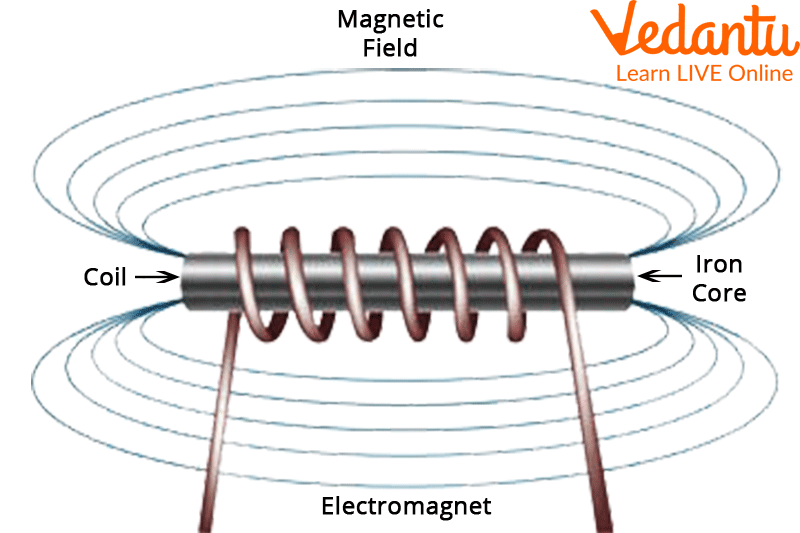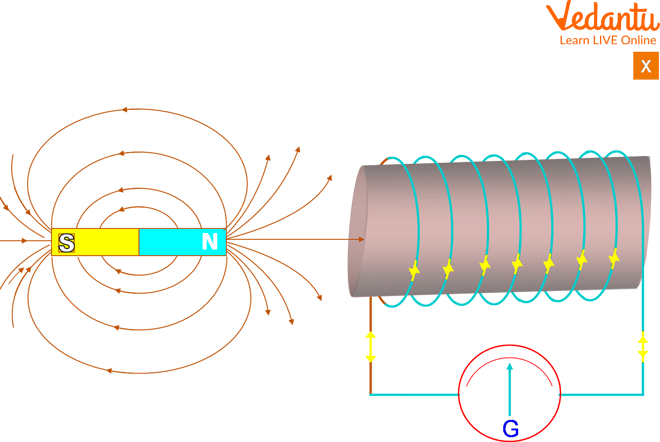




Introduction to Electromagnets
Electromagnets are magnets whose magnetic field is generated by electricity. The magnets used for decoration on your refrigerator are different from this type. It is made from metal materials that are permanently magnetized. These magnets are used in refrigerators because they continuously generate magnetic fields.
A permanent magnet does not create a magnetic field when it is required, like electromagnets. Scrap iron and steel are also moved and picked up using electromagnets in industry.
Electric currents produce electromagnetism. An electric wire moved near a metal compass needle in 1819, a discovery made by Danish scientist Hans Oersted.
Science considered electricity and magnetism to be separate phenomena before his discovery. The first helpful electromagnet was developed by a physicist named William Sturgeon in 1825 that could lift 9 pounds of iron.

Electricity and Magnetism
Working of Electromagnets
Permanent magnets differ from electromagnets. Electricity passes through coils of wire in electromagnets. An electromagnet behaves like a magnet when it has electric current flowing through its coils, which creates magnetic fields. Electronic devices often use electromagnets when magnetic forces are only applied for a short time.
Electromagnets work by creating a magnetic field around a wire as electricity flows through it. By Fleming's right-hand rule, if the thumb, first finger, and second finger are perpendicular to each other (right angle), the thumb represents magnetic thrust, the first finger represents a moving particle, and the second finger represents an induced magnetic field.
There are two names for this rule: dynamo rule or generator rule. The right-hand rule can be used to determine the magnetic field's direction. One wire produces a weak magnetic field. Wires are wrapped in loops to combine the magnetic fields of each to create an electromagnet with a stronger magnet.
Advantages and Disadvantages of Electromagnets
Advantages:
A magnet is very useful when poles need to change and magnetic fields need to be interrupted. Electromagnets are used effectively in magnetic separators. By magnetizing scrap metal, it attracts scrap iron from a pile, and when the current is stopped, it drops the scrap at another location.
To get iron scrap, we use a magnetic separator. Another advantage of electromagnets is their affordability and ease of construction. Their lightweight design avoids damaging the electromagnet's test piece. The use of electromagnets daily is diverse.
Large cranes used in waste yards, for instance, use electromagnets. Electronic and electromechanical devices also use electromagnets.
Disadvantages:
A disadvantage of electromagnets is that they heat up very quickly, which results in a very high loss of energy. Maintaining a constant magnetic field is necessary for a continuous power supply.
Maintaining a constant magnetic field is essential for a continuous power supply. Coils of copper wire are required to generate a strong magnetic field, which requires large amounts of space. Small spaces are not suitable for electromagnets. Because electromagnets generate magnetic fields, short-circuits can damage them and cause serious harm to operators.
Is There a Perfection to be Produced between a Perpetual Attraction and an Electromagnet?

Electromagnet and Permanent Magnet
Permanent Attraction:
There is always a magnetic field present around a permanent magnet. Magnetic materials maintain their magnetic properties for an extended time. Some rare earth alloys, for example, contain iron, nickel, cobalt, etc.
The South-North opposition to an endless attraction is fixed. It can not be changed.
Its energy can not be remade.
Electromagnet:
The South-North opposition of an electromagnet can be altered by changing the direction of the current in the coil.
Its strength can be remade by changing the usual run through it or by changing the number of ranges in it.
The Electromagnetic Field and the Right-Hand Rule
When electricity flows in a long straight line, it creates an indirect or spherical glamorous field around the line according to the right-facet rule, which means the galettes show the direction of the electromagnetic field generated, and the thumb points to the direction of electrons or current flowing in.
Uses of Electromagnetism
Permanent attractions produce much more glamorous fields than electromagnets.
The power of the electromagnets can be acclimated by changing the quantum of current flowing through them.
Electromagnets find their use in numerous effects that we use in our everyday lives.
They're used in cell phones that work on the commerce between the phone signals and raising weighty loads.
Summary
Electromagnets are truly simple to make, and they can be contained. They aren’t dangerous. They're more useful than regular attractions, and they work with electricity. The glamorous material is made of soft iron and we want them all the time. After conducting all the trials, Faraday eventually concluded that if the relative movement was between a captain and a glamorous field, the flux relation with a coil was remade and this change in fluctuation produced a voltage across a coil.
FAQs on How does an Electromagnet Work?
1. Electromagnets are made using what type of current?
Creating a strong magnet requires a permanent magnet DC since DC circuits flow in one direction. Depending on the frequency of the current and the direction, the AC circuit oscillates 50 or more times per second.
The circuit can be damaged due to too much heat generated by this alteration. Using AC over a long period can damage the electromagnet. Wire coils create magnetic fields around nails due to their electric fields. Sometimes, even after removing the nail from the wire coil, the magnet remains.
2. Electromagnets come in different types. What are they?
An electromagnet can be resistant, superconducting, or hybrid.
Resistant: These magnets produce their magnetic field by using copper wires. By passing an electric current through a copper wire twisted around the iron, a magnetic field is generated. Fields are stronger when copper wires are twisted tightly.
Superconductor magnets: A superconductive metal carries current without resistance. The same principle applies to superconductor magnets. Copper atoms are kept away from current flows because of the low temperature. Despite a loss of current, these electromagnets continue to work.
Hybrid electromagnets: These attractions are the composite of the two species of electromagnets, resistant and superconducting electromagnets.
3. Electromagnets are made in what way?
Magnetic fields are generated by electric currents flowing through wires. Coiling the wire can increase magnetic fields. By reducing the distance, more current can flow and a greater magnetic field is created. Depending on the current direction, the magnetic field will follow that direction. Electrons move to produce magnetism and electricity. MRI machines, magnetic separation equipment, motors, generators, solenoids, relays, loudspeakers, floppy disks, electrical engines, and other devices rely on electromagnetics.









